List of Authors
>>About this blog
Recent blog post
|
[Dimini ☆ Cricket]
August 31, 2016 18:00
Just a year ago, I wanted to get useful information about Shell Tea  (Shetland Seap Dog, 3, 1 year old), which became a member of my home, such as how to raise, discipline, prevention of illness, etc. Then, I knew that an organization called Japan Colli Club was in Chuo-ku, visited immediately, received explanations, and joined. (Shetland Seap Dog, 3, 1 year old), which became a member of my home, such as how to raise, discipline, prevention of illness, etc. Then, I knew that an organization called Japan Colli Club was in Chuo-ku, visited immediately, received explanations, and joined.

The Japan Colli Club (J.C.C.) is located on the 8th floor of Ginza Wakaho Building, a little southwest of Harumi-dori St., opposite Kabukiza Theater. My address is Ginza 5-chome 14-8.
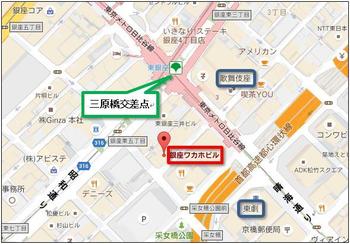
The Japan Cory Club aims to improve and proliferate and spread the cory dog breeds (Rafcory, Smooth Cory, Shetland Seapdog, Border Cory) as sheep dogs and family dogs, and to promote mutual friendship among members.
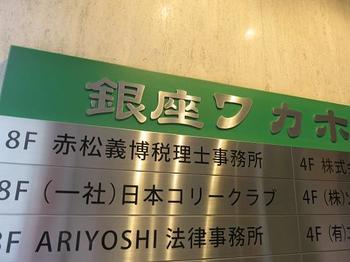
This club was founded in 1953 (Showa 28), and in 2012, it was a club with a history that held a celebration of the 60th anniversary of its founding. and in 2012, it was a club with a history that held a celebration of the 60th anniversary of its founding.
The photo below  shows the lineage testimony issued by j.c.c.c. shows the lineage testimony issued by j.c.c.c.
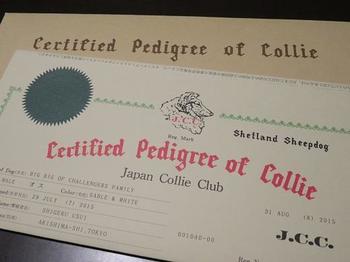
Anyone who breeds a collie dog breed or who loves a collie dog breed even if they do not currently have a collie dog breed can join.
 The photo below shows the textbook, rules and standards, and guidance D.V.D issued by j.c.c. The photo below shows the textbook, rules and standards, and guidance D.V.D issued by j.c.c.
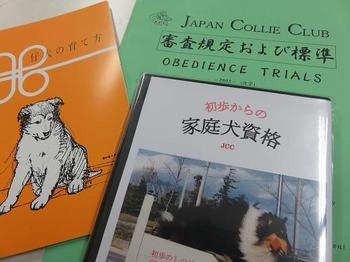
If you join, you can register a puppy and participate in events organized by Colli Club Books and Branchs.
You will  also receive a newsletter "Kory Fancy" issued once every two months (full of information and photos about Collie and Shell Tea also receive a newsletter "Kory Fancy" issued once every two months (full of information and photos about Collie and Shell Tea ) )

I have just joined, but I would like to actively participate in club-sponsored events and support  the happy life (dog life the happy life (dog life ) of my dog. ) of my dog.

The information and materials introduced on this blog were provided by the Japan Colli Club Public Relations Department. Thank you very much
Click here for the website of J.C.C. Japan Collie Club ⇒
http://www.collieclub.jp/index.htm
     
[Chuo Kotaro]
August 31, 2016 09:00
I had the opportunity to guide Tsukiji in mid-August, and I studied Tsukiji again in about a month.
I was reminded that it was an interesting place.
If you classify the charm of Tsukiji, I think it will be categorized below.
①History of Tsukiji (1) Within and outside Tsukiji Markets
②History of Tsukiji (2) Landfill and Honganji
③History of Tsukiji (3) Foreign Settlements
④Building heritage
⑤A treasure trove of gourmet
④⑤If you understand it in relation to the history and location of 1-3, I think it will become even more attractive.
This time, I would like to focus on "4 architectural heritage" from the charm of Tsukiji.
I think.
I think the architectural heritage of Tsukiji can be classified as follows.
A. The streets of the early Showa period (Machiya group, signboard architecture, alley)
B. Temple
C. The remnants of foreign settlements
D. Fan-type Tsukiji Market
Of these, the old townhouses, signboard architecture, and some temples in B are the World Monument Foundation.
The U.S. non-profit organization has been selected as a list of crisis heritages to be announced once every two years.
It is a world-famous substitute for Historic buildings.
Below is a map of the distribution of architectural heritage.
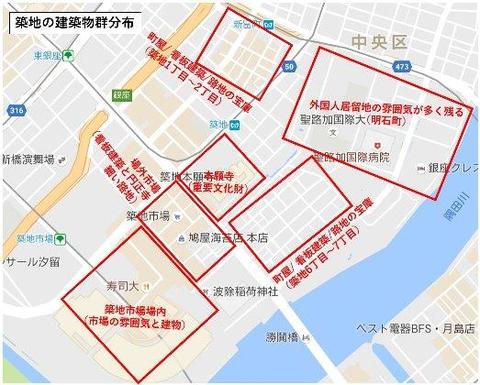
◆◆Distribution of architectural heritage around Tsukiji◆◆
A. The streets of the early Showa period (Machiya group, signboard architecture, alley)
Machiya, signboard architecture, and alleys are the part of Tsukiji 1-chome and 2-chome near Shintomi-cho.
It is often found in the area from Tsukiji 6-chome to 7-chome.
Personally, I like the neighborhood of 6-chome, which leaves a rich Showa atmosphere in a wide area.
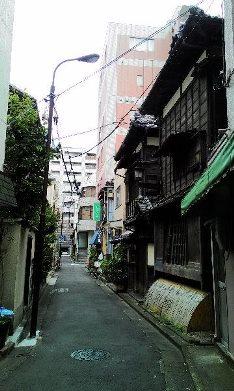 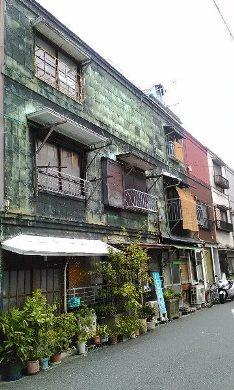
<Alley of Tsukiji 2-chome, signboard construction of Tsukiji 6-chome (copperboard)>
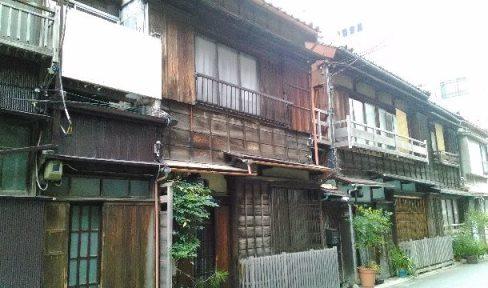
<Machiya of Tsukiji 6-chome>
On the other hand, out-of-market markets tend to be overlooked due to congestion and the eaves of stores.
If you look up, you will notice that there are many signboard architectures.
In addition, there is a very narrow alley connecting Higashi-dori, Naka-dori and Nishi-dori on the main street.
There are many shops on both sides of the alley, so "Eh? There's a shop like this."
You can meet a fresh surprise.
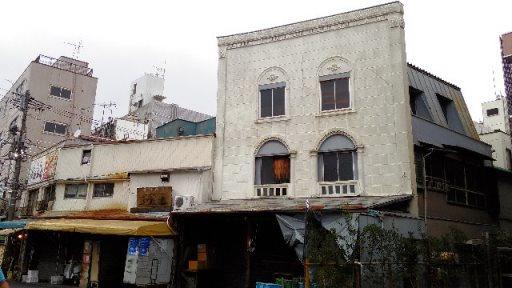 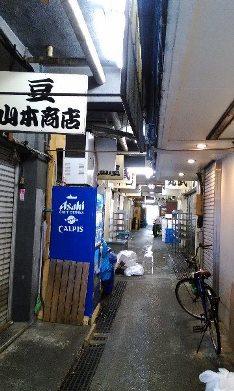
<Signboard construction (mortar) outside the hall, alleyway through outside the hall>
By the way, "signboard construction" means that a wooden building is surrounded by copper plate or mortar to prevent fire resistance.
It is a raised building and is classified into "copper plate type" and "mortar type" according to the material of the enclosure.
We were able to apply various designs such as patterns on copper plates and mortars like signboards.
It seems to be called "signboard architecture".
I hope these streets will remain forever.
B. Temple
I can't touch it here because it's too commonplace for Tsukiji Honganji.
Outside the hall was originally the Terauchi town of Honganji, where many temples are lined up neatly and densely.
I was there.
Most of them were relocated after the Great Kanto Earthquake, and now only a few remain.
In terms of historical buildings, I don't think "Enshoji" in this cannot be removed.
The side of Enshoji is integrated with stores in the out-of-store market, and it is like a fusion of signboard architecture and temples.
It has a rare landscape that can not be seen anywhere else, and I think it is a must-see.
(I want this landscape to remain.)
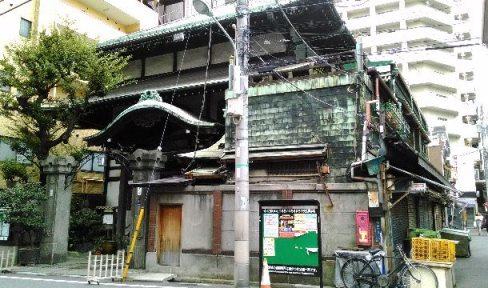
<Enshoji Temple (on the right side is integrated with the store)>
C. The remnants of foreign settlements
I think that foreign settlements are from now around Harumi-dori St. to around Irifune.
It looks good, but the center is around Akashicho.
As for buildings, the Toysler Memorial Hall and Catholic Tsukiji Association have remained since that time.
It's left.
There is also the St. Luke Chapel, gas lights remain, and the area is green and Western-style.
I think you can feel the atmosphere.
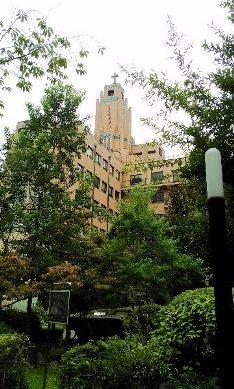 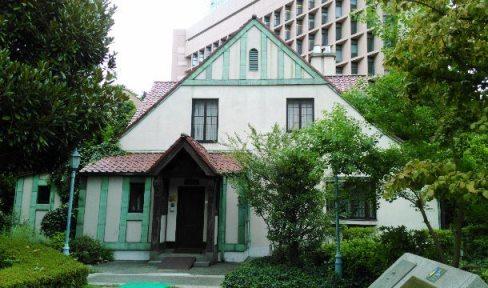
<St. Luke Chapel, Toysler Memorial Hall>
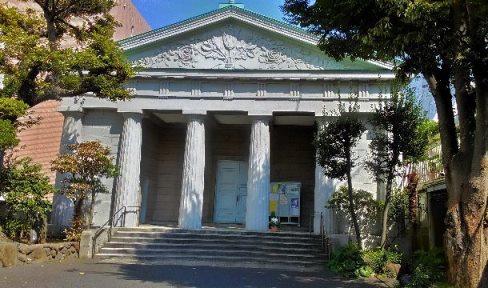
<Tsukiji Catholic Church>
D. Fan-type Tsukiji Market
The building of the fan-shaped Tsukiji Market itself, the sales floor of wholesalers in the hall, and the fish riverside Yokocho.
The atmosphere of the building and the vibrant market is also one of the attractive buildings for me.
However, this will be gone after the relocation to Toyosu, so go now.
Let's keep it.
Then I will add one point.
Tsukiji is almost reclaimed now, but originally there is a waterway around the Tsukiji River.
It is a stretched land, and there are many places where the site is a green road, and the greenery is rich.
Especially in the area around St. Luke's International Hospital, it feels good to walk. Old maps and contemporary maps,
In addition, it is fun to take a walk around the area while comparing the photos of the time.
This time, I introduced Tsukiji from the viewpoint of architectural heritage.
If I have the opportunity, I would like to write an article from the viewpoint of gourmet.
History, architecture and gourmet. The market will move, but even so Tsukiji will create a charm that won't get bored.
It's overflowing.
[Slow of Satsuki's Koi]
August 25, 2016 09:00
It is said that "Edo's specialty samurai bonito daimyo Koji Hirokoji tea shop purple fire extinguisher Nishiki-e fire middle up in a fight against Iseya Inari and a dog's lie."
●Samurai
It seems that there were many samurai in the town of Edo, but "Kidai Shoran" depicts the lives of the common people of Edo, but since there is no memory of samurai also appearing, I will review it again soon .
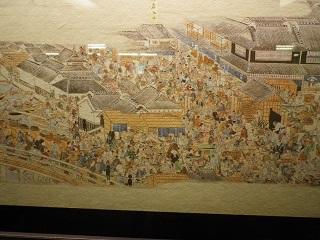
Kyodai Shoran Nihonbashi
●Bonito
As you know, is it true that "I ate even if I put my kami in quality"?
According to the story of fish, the fish market currently in Tsukiji is in Nihonbashi until the Great Kanto Earthquake, and it seems that it was crowded with being called "Asasen Ryo Fish Bank". By the way, it seems that these are called "Edo 3,000 Ryo" and "Night Senryo Yoshihara". At the foot of Nihonbashi, there is a monument to the origin of the fish market.
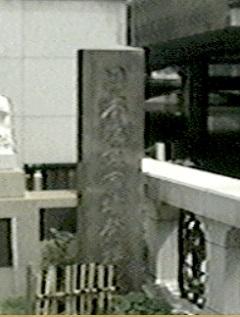 Monuments originating from the Nihonbashi Fish Bank Monuments originating from the Nihonbashi Fish Bank
●Daimyokoji
It is said that it refers to the area around Marunouchi to Otemachi where there were many daimyo mansions. In this situation, there is an aerial photograph near Tokyo Station in the underground concourse of Mitsukoshimae Station, and if you look at it, the division of the town is clear at a glance. You can clearly see Samurai residence and the town of the townspeople. (Marunouchi side: Daimyoyashiki Yaesu side: townspeople) Please see here along with "Kidai Shoran".
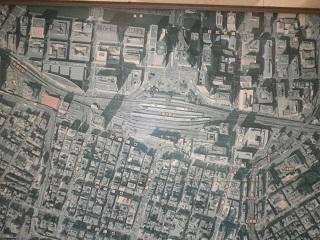
Aerial photograph around Nihonbashi
●Hirokoji
A wide road. I think this path of Hirodai Shoran is one of Hirokoji Temples. In this street, near the Tokaido Ginza, the Hibiya and Tsukiji sides of the street seem to have been reclaimed later and seem to be slightly lower, but I do not understand well in this photo. Look at it with your own eyes.
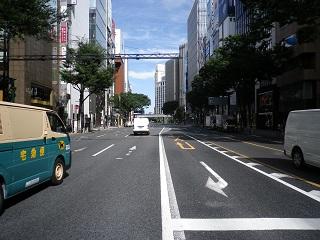
See the Hibiya area from Ginza 4-chome intersection
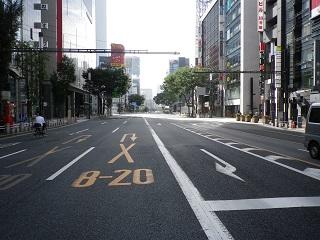 See the Tsukiji area from Ginza 4-chome intersection See the Tsukiji area from Ginza 4-chome intersection
Continue
[Silver]
August 23, 2016 18:00
I think the Police Museum is a very good environment where you can learn about the police system from the Meiji government. It is also a place where children are pleased, such as the experience of a white motorcycle police officer.
So, I wanted to teach you and your children as a place for free study during summer vacation.
Unfortunately, it is suspended due to the renewal work.
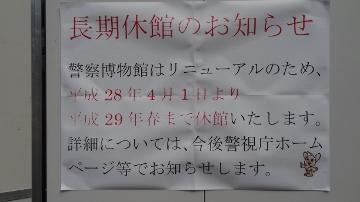
The museum will be closed until the spring of 2017. I'm going to visit the renovated police museum with my grandchildren.
[Shiba Inu]
August 23, 2016 12:00
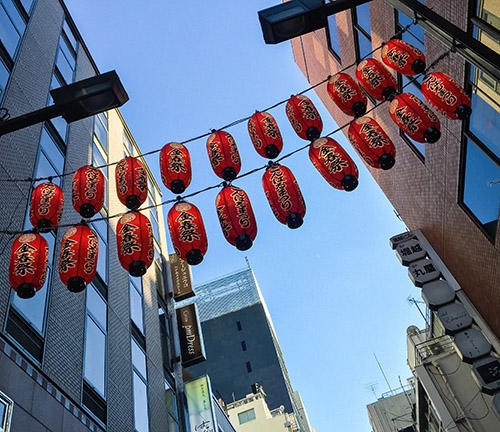
Did you know that a Noh festival called "Noh Noh Kinharu Festival" is held in Ginza once a year in August?
Various events such as Noh lectures and parent-child experience classes will be held around Kinharu-dori in Ginza for five days. The big bird is the street dedication Noh performed on Kinharu Street!
The precious performances performed in the dusk are truly worth a look. I would like to see it once....But I don't have much information in advance so I can't get back....I think there are some people. For such a person! This time, I would like to briefly introduce a series of flows for observing the street dedication Noh.
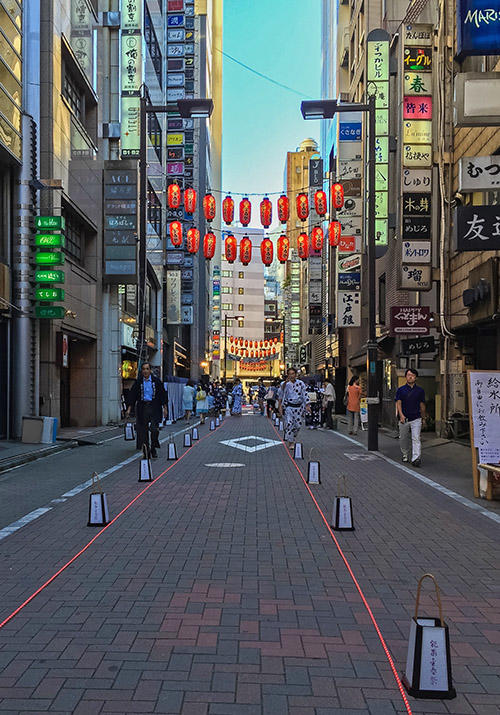 It's Kinharu Street, the venue for the Golden Spring Festival. The location is as follows. The station is close to Shimbashi. It's Kinharu Street, the venue for the Golden Spring Festival. The location is as follows. The station is close to Shimbashi.
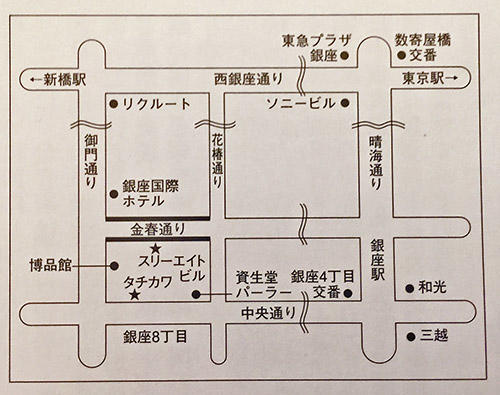
It is free to visit Noh at the venue, but since it is usually a full thanks and you will not be able to enter the venue, you will receive a numbered ticket (seat reservation ticket) from the person in charge in advance. A numbered ticket will be distributed per person on Kinharu Street from 4:00 pm on the day....But it's probably too late to go at four o'clock. At 2 o'clock, there are already about 10 waiting queues (however, this waiting column is voluntary, and the operation will maintain it after 3 o'clock).
It's this procession at 4:00 pm when the distribution starts!
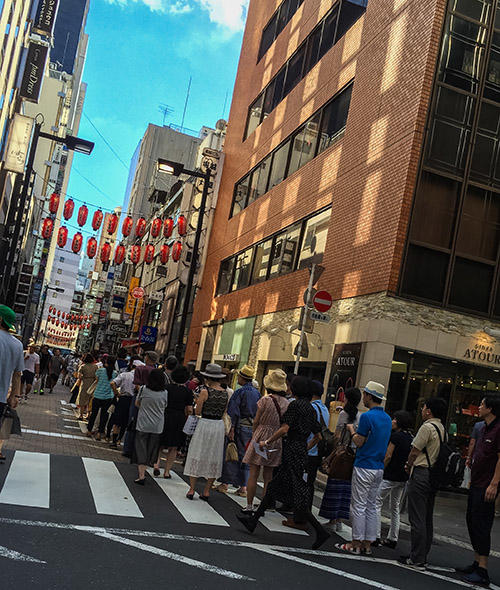
The block is lined up all the time.
If you get the numbered ticket safely, you're free to rest. It's okay if you're back to your seat by five forty-five p.m. The performance starts at six p.m. If you do not return to your seat by time, the reserved ticket will be invalidated and will be handed over to others.
Near the venue, Toyo Iwaine (very recommended!) There are many things, so there is no shortage of walking until time.
Here's the point!
The numbered ticket is a seat reservation ticket, so the person in charge will adjust when distributing it. You may ask your preference in a vacant seat. However, there is also a balance such as the number of consecutive numbers, so it is not always possible to say that "it is better to line up early".
First of all, in the front row, people involved and schools sit down. In general, you will sit in a vacant seat after that. Therefore, there is a great possibility that "one person who came later" will be a better seat than "the three people who were lined up earlier".
In addition, if there are vacant seats even after the start time, those who do not have a numbered ticket with reserved seats will be passed sequentially. And the vacant seats are "seats related parties". Then, the person who happened to be there without being lined up at all and went to the front row! ! What a thing can happen. In the unlikely event of such a disappointing situation, don't get angry...Don't be sad...I also need Men Tal (laughs).
Even in narrow passages between seats, those who do not have a numbered ticket will sit on a cushion and watch. Fortunately, you may be able to go to the front row. Conversely, if the timing is right, there is a possibility that you can tour without waiting for a numbered ticket.
Well, it's the venue that has been set up.
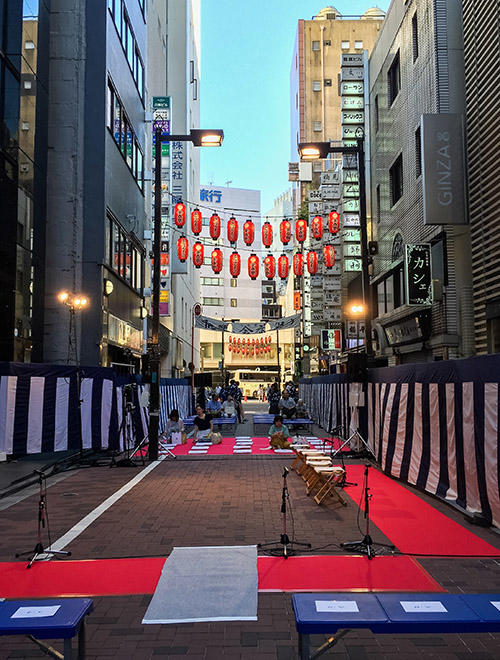
An altar made in the back.
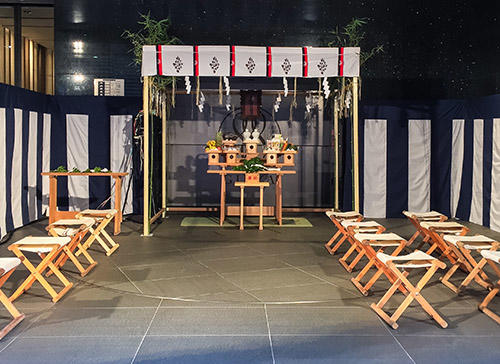
It is a bit difficult and difficult to understand to take a picture of the entire venue with a camera, so please take a look at this overall picture.
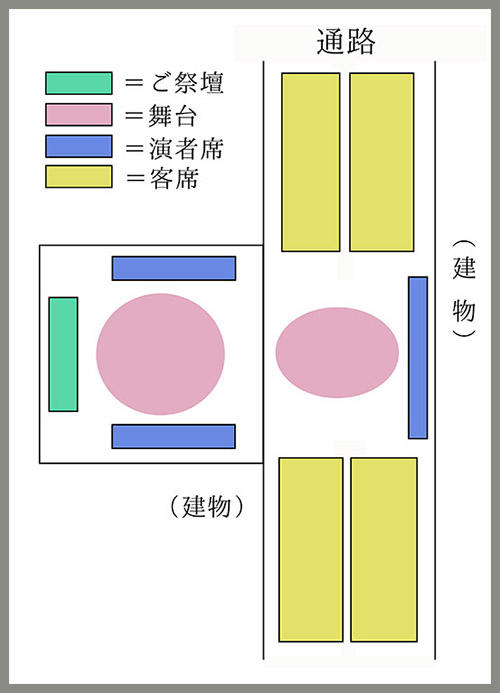
It is such a arrangement, so you may understand somehow, but it is basically not so good from the general audience! ! ! This is inevitable because the Golden Spring Festival dedication is not a box office but a Shinto ritual, and there are schools. However, as "I can't see it more than I thought", you can see it roughly, and there is a kneading procession at the beginning, so you can see the performers up close there!

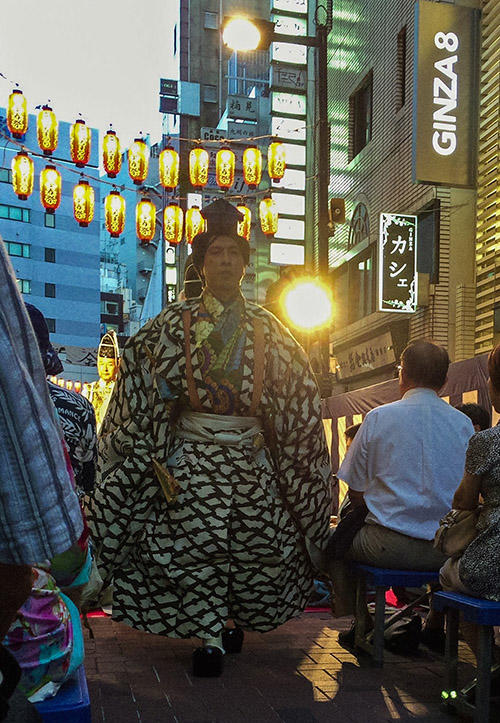
Shooting is prohibited once the performance starts. Some people keep taking pictures even if they are warned, but I think it's a bad act to take pictures of Shinto ritual casually without permission....。
The performance time is about an hour. You can enjoy valuable performances that you can not usually see with commentary from experts. Anyway, I'm overwhelmed by the atmosphere. At the time of encounter, the appearance of stepping on an old performance in the neon lights of Ginza is truly mysterious. There is a sound of shadows and clothing, and even if you can't see the performer, there may be something that can be transmitted.
After the performance, visitors will also visit altar.
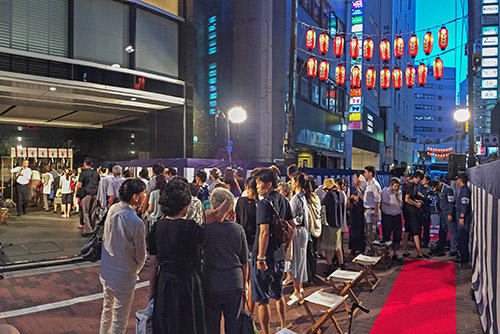
I have to get a seat with a lot of trouble....There is a hurdle, but I think it will be a valuable experience. Think about willows in Ginza.
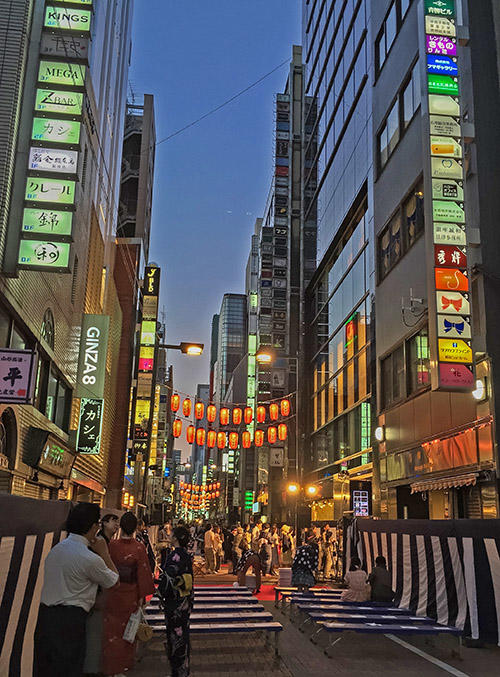
You can also get a nice brochure.
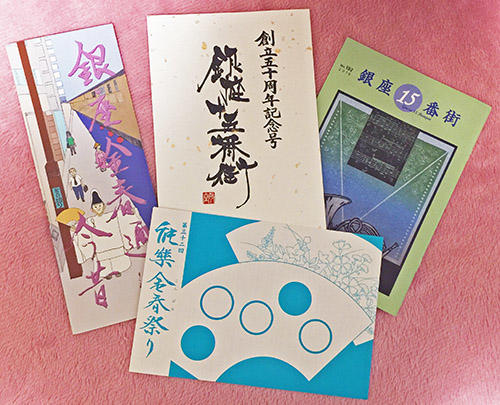
[Ponchan]
August 19, 2016 09:00
Because Hamarikyu Garden is adjacent to Tsukiji Market, many tourists visit not only from Japan but also from foreign countries throughout the year.
There are currently three teahouses around the tide pond (Oizumi).
Based on the Tokyo Olympics held in 2020, construction of the fourth Ochiya (Hawk's Ochiya) is scheduled to begin by the end of the year.
Unlike the tea room in the tea ceremony, Ochiya is a place where guests were invited to eat while enjoying the scenery of the garden, and spent an elegant time singing waka.
This time, I will focus on Ochiya's nail hiding.
Ochiyaya of Nakajima Restructed in 1953 A nail hide-a crane
Pine Ochiyaya Restore in 2010 Hide-pinecone Cicada
Ochiyaya of Tsubame Restore in 2015 Hidden-Tsubame
A nail hiding is a formal Japanese-style house that hides the head of a large nail that has been hit at the intersection of pillars, fishing bundles and long pushes. It is a decorative item in the house where the head of the nail is covered so that it cannot be seen on the surface. It is also said to be a ruin. It is unlikely to be used in private homes these days.
The architectural style has been improved, nails have become ornaments, and various shapes have been made of various materials.
The materials are often made of wood, iron, copper, etc., but craft-like materials made from beautiful colored pottery and cloisonne are also made.
It seems that many patterns, flowers, leaves, fruits, animals, insects, etc. are used in the design of nail hiding.
The nail hide of the daffodil in Katsura Imperial Villa became a New Year's stamp in 1975, so I think some people remember it.
The architectural style of Ochiya in Hamarikyu Garden is Sukiya-style Shoin-style, so nail hide is about 80% in size compared to Shoin-style.
The inside of Ochiyaya in Tsubame
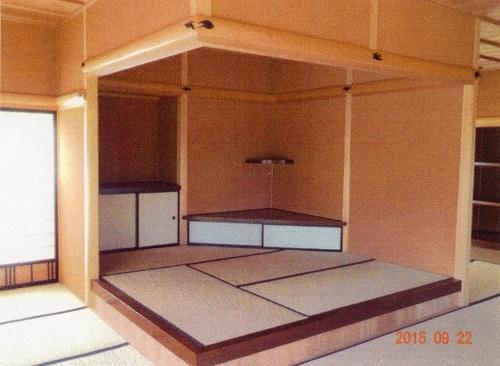
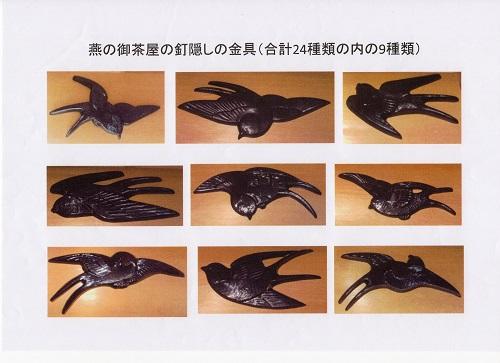
Currently, Ochiya in Nakajima can be put in at all times, and Matsuno Ochiya is open to the public every Thursday from 1 pm to 3 pm (with a guide explanation, but in fine weather), so you can see it . Tsubame's Ochiyaya, completed at the end of March last year, cannot be inside unless it is a special opportunity (Cultural Property Week, etc.), and it is difficult to understand from outside through glass.
Tsubame's Ochiya, which has 24 kinds of nail hidings in all shapes, please get information on the special release on the website.
|
Links
|
![]() (Shetland Seap Dog, 3, 1 year old), which became a member of my home, such as how to raise, discipline, prevention of illness, etc. Then, I knew that an organization called Japan Colli Club was in Chuo-ku, visited immediately, received explanations, and joined.
(Shetland Seap Dog, 3, 1 year old), which became a member of my home, such as how to raise, discipline, prevention of illness, etc. Then, I knew that an organization called Japan Colli Club was in Chuo-ku, visited immediately, received explanations, and joined.![]()
![]()
![]()
![]() and in 2012, it was a club with a history that held a celebration of the 60th anniversary of its founding.
and in 2012, it was a club with a history that held a celebration of the 60th anniversary of its founding.![]()
![]() shows the lineage testimony issued by j.c.c.c.
shows the lineage testimony issued by j.c.c.c.![]()
![]()
![]() The photo below shows the textbook, rules and standards, and guidance D.V.D issued by j.c.c.
The photo below shows the textbook, rules and standards, and guidance D.V.D issued by j.c.c.![]()
![]()
![]() also receive a newsletter "Kory Fancy" issued once every two months (full of information and photos about Collie and Shell Tea
also receive a newsletter "Kory Fancy" issued once every two months (full of information and photos about Collie and Shell Tea![]() )
)![]()
![]() the happy life (dog life
the happy life (dog life![]() ) of my dog.
) of my dog.![]()
![]()
![]()
![]()
![]()
![]()
![]()
![]()

















 Monuments originating from the Nihonbashi Fish Bank
Monuments originating from the Nihonbashi Fish Bank

 It's Kinharu Street, the venue for the Golden Spring Festival. The location is as follows. The station is close to Shimbashi.
It's Kinharu Street, the venue for the Golden Spring Festival. The location is as follows. The station is close to Shimbashi.












